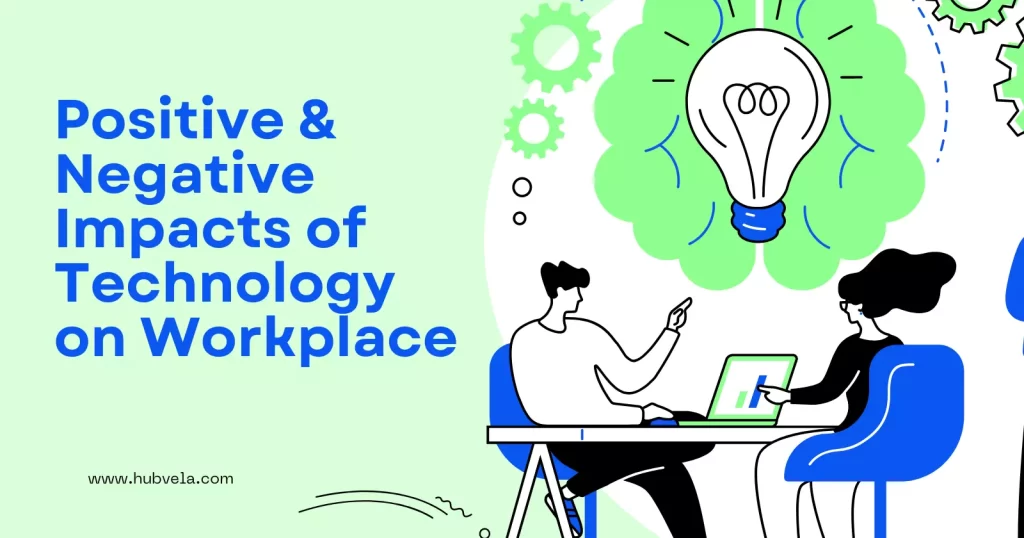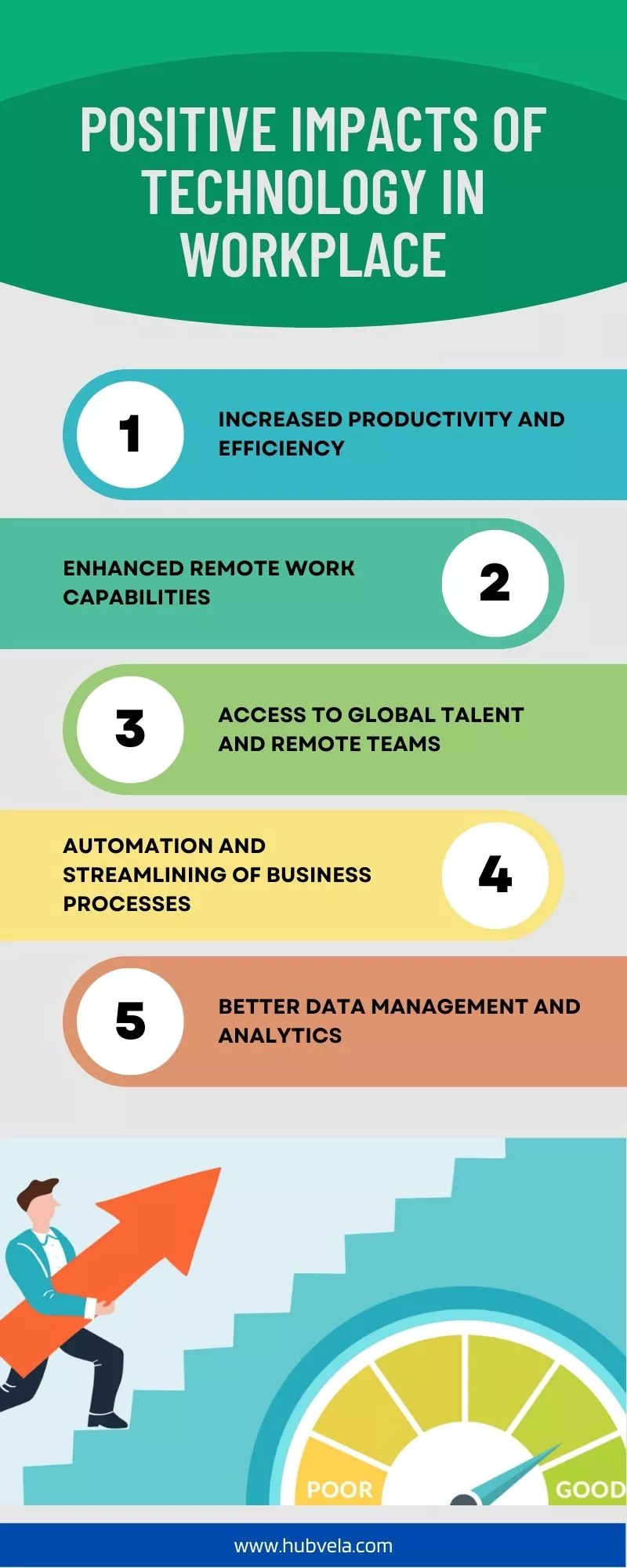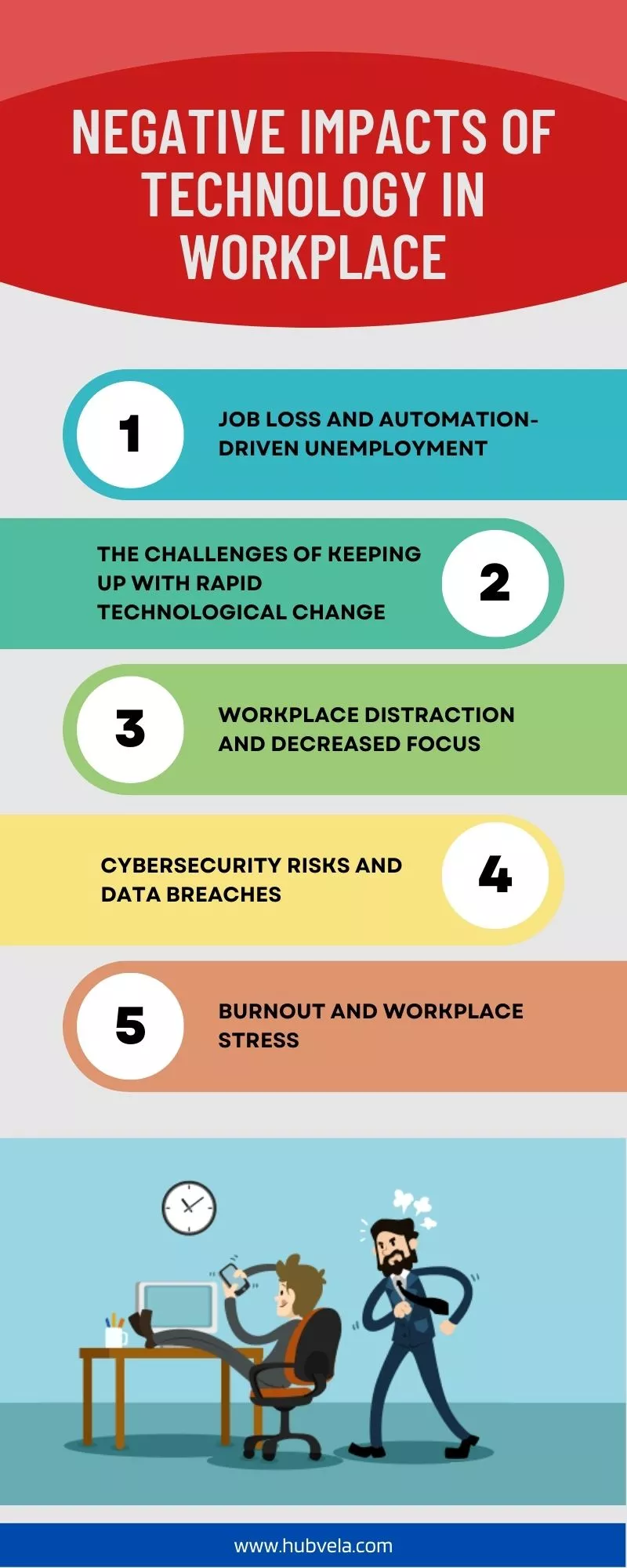Technology has become an integral part of the modern workplace, with many businesses relying on it to streamline operations and improve productivity.
However, technology can also have both positive and negative impacts on the workplace.
On one hand, it can increase efficiency and provide employees with access to a wealth of information.
On the other hand, it can lead to distractions, reduced face-to-face communication, and even job loss in some cases.
In this article, we will explore both the positive and negative impacts of technology in the workplace.

--Advertisement--
Positive Impacts of Technology on Workplace
Technology has become an integral part of the modern workplace, and its impact on productivity, efficiency, and employee well-being cannot be overstated.
With the use of digital tools, applications, and systems, organizations have been able to streamline processes that were once manual and time-consuming.
Collaboration software like Office 365 and Google Docs allow teams to work together in real-time, while project management tools like Trello help managers organize team workloads more efficiently.
We will explore some of the major positive impacts of technology in the workplace.

1. Increased Productivity and Efficiency
The use of technology in the workplace has had a positive impact on productivity and efficiency.
With digital tools, applications, and systems, organizations have been able to automate manual processes that were once time-consuming.
This has allowed employees to complete tasks more quickly and accurately, resulting in increased productivity.
Additionally, working from home during the COVID-19 pandemic has shown that better mental and physical health statuses, increased communication with coworkers, and having a dedicated workspace can positively influence productivity.
Positive work cultures have also been shown to improve employee well-being and productivity.
There are various strategies that individuals can employ to increase their own productivity, but ultimately it is the combination of technology and organizational culture that can lead to significant improvements in workplace efficiency.
2. Enhanced Remote Work Capabilities
With new technologies, work can be made more efficient and collaboration can be boosted in virtual ways, making it more adaptive to remote working styles.
Remote work technology has also allowed for a reduction in expenses for office rental and traveling, as well as more creative ways to engage employees.
An employee experience platform can be used to surface and analyze aggregate operational and experience data to help leaders encourage healthy work habits and nudge employees toward better practices.
Technology has created a collaborative work environment that is not limited to big corporations but is also helping small business owners achieve big goals.
Additionally, technology has enabled remote work opportunities for people with disabilities, which is another positive outcome of the pandemic experience.
3. Access to Global Talent and Remote Teams
With remote work, employers can hire geographically distributed talent and reduce overhead expenses, while employees can gain flexibility, save time, and reduce transportation and some child-care costs.
This allows companies to tap into a wider pool of talent from around the world, which can lead to increased creativity and productivity.
Additionally, video conferencing technology has become a great equalizer in meetings by giving everyone an equal voice regardless of their location or seniority.
While there are challenges to managing global teams such as cultural differences and communication barriers, these can be overcome with proper management techniques
4. Automation and Streamlining of Business Processes
By introducing new technologies like artificial intelligence (AI), machine learning (ML), and robotic process automation (RPA), businesses can simplify or eliminate unnecessary work-related tasks to improve efficiency.
Automation has the potential to transform processes and make businesses more competitive in a quickly changing marketplace, especially for smaller businesses or industries that rely on manual labor.
Automating business processes saves time and money, reduces the amount of manpower required to complete key tasks, and allows workers to focus on more important projects.
By automating repetitive tasks, employees can focus on more creative and strategic work, leading to increased job satisfaction and productivity
5. Better Data Management and Analytics
Data management technology provides opportunities for improved organizational consistency, increased productivity, greater collaboration and communication, and faster business decisions.
As organizations create and consume data at unprecedented rates, data management solutions become essential for making sense of the vast quantities of data.
Data management skills involve looking for patterns, understanding database design concepts, and participating in short and long-term planning of database projects.
Advanced data analytics can provide valuable insights into employee satisfaction, finances, customer satisfaction, etc., which can contribute significantly to decision-making, business growth, and overall business prosperity.
Therefore, better data management and analytics can help businesses make informed decisions that lead to growth and success.
6. Improved Communication and Collaboration
Effective communication ensures that everyone understands their duties and responsibilities, helps build quality client and employee relationships, and keeps employees engaged and productive.
Technology can help improve communication by providing various tools such as video conferencing, instant messaging, and email.
Collaboration is also important in the workplace as it often leads to more communication between colleagues and increased productivity.
Technology can facilitate collaboration by providing platforms for team members to work together on projects, share ideas, and provide feedback.
To foster positive communication and collaboration in the workplace, individuals can practice techniques such as putting away distractions, having a positive outlook, respecting others’ opinions, managing time effectively, and being enthusiastic
Negative Impacts of Technology on Workplace
Technology has revolutionized the way we work, making it easier and more efficient to complete tasks. However, it also has negative impacts on the workplace that cannot be ignored.
Employees are expected to be available online at all times, which can cut into their rest and leisure time.
Automation is causing job loss across the globe, and technology can negatively impact interpersonal relationships and communication in the workplace.
While technology has many benefits, it is important to recognize its negative impacts as well.

1. Job Loss and Automation-Driven Unemployment
The rise of automation has led to job loss and unemployment, which is one of the negative impacts of technology in the workplace.
While automation can create new jobs over time, it can also replace jobs without adding much productivity to the economy.
A recent report from the World Economic Forum predicted that by 2025, automation will disrupt 85 million jobs globally.
In the US, a detailed analysis found that 25% of Americans work in jobs where 75% of tasks could be automated by currently available technologies.
This has caused difficulty and anxiety for people who have lost their jobs due to automation-driven unemployment.
However, technology could also create millions more jobs than it displaces.
It is important for policymakers and businesses to respond to job losses from technology by investing in education and training programs that help workers acquire new skills and transition into new industries.
2. The Challenges of Keeping Up with Rapid Technological Change
Rapid technological change can have negative impacts on the workplace. One challenge is that it can outpace the capacity of governments and society to adapt to the changes that new technologies bring about, perpetuating inequalities and raising ethical questions.
Another challenge is that companies can end up dedicating significant resources to developing technological capabilities that provide only basic functionality instead of a competitive advantage.
Additionally, technological change has pushed income inequality higher and generated fears about job displacement.
Policymakers need to address these challenges by creating clearer incentives and better policies for both private- and public-sector entities, as well as involving people with a wider range of experiences and expertise in the technology development and design process.
3. Workplace Distraction and Decreased Focus
According to a CareerBuilder survey, mobile phones and texting are the most disruptive distractions at work, followed by the internet and gossip.
Other common distractions include general office noise, chatty coworkers, and interruptions.
These distractions can lead to cognitive weariness, emotional exhaustion, physical fatigue, lack of interest or motivation, lack of effort at work, and decreased productivity.
Even small distractions can derail productivity and degrade the overall quality of people’s work.
Therefore, it is important for employers to implement strategies to minimize workplace distractions such as setting clear expectations for employees’ use of technology during work hours or providing quiet spaces for focused work.
4. Cybersecurity Risks and Data Breaches
Technology has brought many benefits to the workplace, but it also poses cybersecurity risks and data breaches that can have negative impacts on organizations.
With more knowledge workers working remotely and greater use of the public cloud, highly connected supply chains, and cyber-physical systems, new attack surfaces have been exposed.
A data breach can be costly for companies, with the global cost of a typical data breach recovery being $3.86 million.
The impact of a data breach can also extend beyond financial losses including reputational damage and loss of customer trust.
Cyber risk is based on the probability of a bad event happening to a business’s information and communications systems.
The 2021 attack on Colonial Pipeline disrupted gas supplies for days, highlighting the real-world impacts of cyberattacks on critical infrastructure.
Therefore, organizations should invest in AI and other cybersecurity measures to avoid waste of time and resources in recovering from any data breach.
5. Burnout and Workplace Stress
According to a study by the American Psychological Association, nearly 3 in 5 employees reported negative impacts of work-related stress, including lack of interest, motivation, or energy and lack of effort at work.
Job burnout can be caused by monotonous or chaotic work environments, lack of social support, and work-life imbalance.
Workplace burnout symptoms and job stress can lead to physical health issues such as excessive stress, fatigue, increased likelihood of heart disease, and high blood pressure.
Burnout reduces job productivity and boosts absenteeism and job turnover.
The return to the office after remote work due to technology during the pandemic has also had a negative impact on mental health for some employees.
It is important for employers to recognize these issues and take steps to address them in order to create a healthy work environment.
6. The Risk of Technological Dependence in the Workplace
While technology has brought many advantages to the workplace, it can also lead to over-reliance on technology and a decrease in autonomy for workers.
This can result in negative outcomes such as decreased job satisfaction and increased stress levels.
Leaders of organizations can play an active role in designing workplaces that encourage healthy technology habits and prevent over-dependence on technology.
It is important to recognize the potential risks of technological dependence and take steps to mitigate them, such as setting boundaries around technology use and encouraging face-to-face communication.
Conclusion on the Positive and Negative Impacts of Technology on Workplace
In conclusion, technology has both positive and negative impacts on the workplace. On the positive side, technology has made work easier and more efficient, allowing for remote work and collaboration across distances.
It has also enabled businesses to reach a wider audience and increase productivity.
However, there are also negative impacts of technology in the workplace such as employee distraction, loss of privacy, and the expectation to be available at all times.
It is important for companies to find a balance between utilizing technology to improve their operations while also being mindful of its potential negative effects on employees’ well-being.



This website was so useful and information rich!